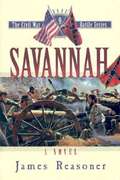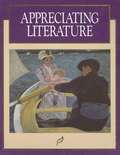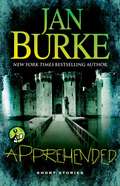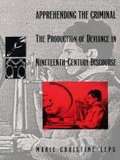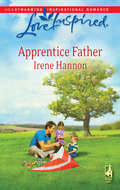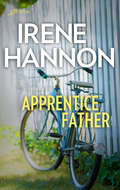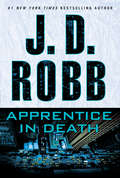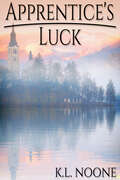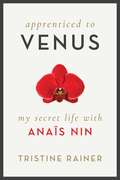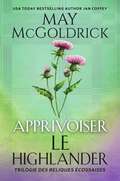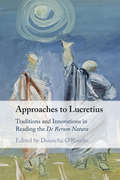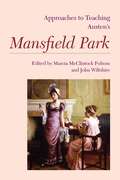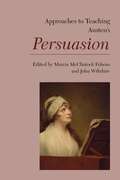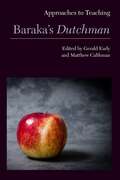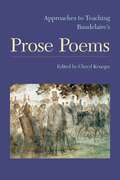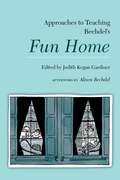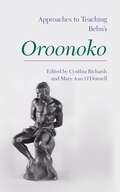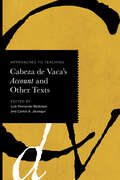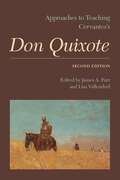- Table View
- List View
Appomattox (The Civil War Battle Series, Book #10)
by James Reasoner[From the back cover] As the sun rose in the sky and approached high noon, skirmishes broke out around the village of Appomattox Court House itself. The Yankees were crowding the embattled Confederates on all sides. Mac heard the nearby firing and stood up. Patrick Malone and his sister, Kathleen, had gone back into the house earlier. Now, as they tried to rush out to see what was going on, disregarding their mother's order to stay inside, Mac moved to block their path. He stood in the doorway. "Go on back, children. This is no place for you." He glanced over his shoulder and saw both Confederate and Union soldiers running through the fields. They stopped behind trees and rock fences and took potshots at each other. The shooting was sporadic, but even so, men on both sides were hit. They stood up, cried out, died. Mac's heart pounded as he watched the skirmish. Suddenly, several Yankees came running around the corner of the house. One of them saw Mac standing there in his cavalry uniform, skidded to a stop, and threw his rifle on his shoulder. Mac stood still. He heard a step behind him, and Norah Malone said, "Major ...?" He put out a hand, motioning for her to stop where she was, but he never took his eyes off the Yankee who was drawing a bead on him. The soldier was a grizzled old-timer with more gray in his beard than black. Probably he had been a member of the regular army before the war, and he had fought and survived all the way through four years of combat. Mac met his gaze steadily as the Yankee peered at him over the barrel of the rifle.
Appreciating Literature: Signature Edition
by Editors at the McGraw-Hill-GlencoeThis text offers some great literature to think about and an organized way to do so, through skills like comparing characters, analyzing points of view, contrasting settings, inferring outcomes etc.
Apprehended
by Jan BurkeFrom the New York Times bestselling suspense author Jan Burke comes a brand-new e-short story with the added bonus of three short stories from the Eighteen anthology. Apprehended is a mini-anthology containing a brand new short story from Jan Burke: "The Unacknowledged," which features the fan-favorite investigative reporter Irene Kelly, back in her journalism school days. Also included are three short stories from the previously published Eighteen: "Why Tonight," "A Fine Set of Teeth," and "A Man of My Stature."
Apprehending the Criminal: The Production of Deviance in Nineteenth Century Discourse
by Marie-Christine LepsIn this wide-ranging analysis, Marie-Christine Leps traces the production and circulation of knowledge about the criminal in nineteenth-century discourse, and shows how the delineation of deviance served to construct cultural norms. She demonstrates how the apprehension of crime and criminals was an important factor in the establishment of such key institutions as national systems of education, a cheap daily press, and various welfare measures designed to fight the spread of criminality.Leps focuses on three discursive practices: the emergence of criminology, the development of a mass-produced press, and the proliferation of crime fiction, in both England and France. Beginning where Foucault's work Discipline and Punish ends, Leps analyzes intertextual modes of knowledge production and shows how the elaboration of hegemonic truths about the criminal is related to the exercise of power. The scope of her investigation includes scientific treatises such as Criminal Man by Cesare Lombroso and The English Convict by Charles Goring, reports on the Jack the Ripper murders in The Times and Le Petit Parisien, the Sherlock Holmes stories, Stevenson's Strange Case of Dr. Jekyll and Mr. Hyde, and novels by Zola and Bourget.
Apprendre à cuisiner comme une jeune pionnière
by Amber Richards Thomas GanichotCe livre éducatif raconte la vie d’une jeune pionnière, son apprentissage de la cuisine ainsi que d’autres aspects de sa vie. Il s’adresse aux jeunes filles de 8 à 13 ans, en fonction de leurs niveaux de lecture et de leurs centres d’intérêts. Des photographies d’époque viennent également enrichir ce livre. Le livre donne une idée concrète de la vie, des outils et de l’équipement à l’ère des pionniers, de l’obtention de leurs ingrédients et de leur méthode pour conserver la nourriture sans réfrigérateur. Mon souhait en tant qu’auteur était d’aider les jeunes filles à avoir une idée concrète de ce qu’était la vie quotidienne au début de l’histoire américaine. Ce livre montre ainsi les différences entre le mode de vie des pionniers et le nôtre. Le livre contient également deux recettes, l’une pour une tarte aux pommes et l’autre pour des biscuits. Les jeunes filles pourront donc, avec l’aide d’un adulte, essayer de les réaliser à la maison. Ce livre peut également s’inscrire dans un projet d’école à la maison.
Apprentice Academy: The Unofficial Guide to the Magical Arts (Apprentice Academy)
by Hal JohnsonFor readers who have always wanted to enroll in a school for magic--be it Hogwarts with Harry Potter or Camp Halfblood with Percy Jackson! Wizard lovers will delight in pretending they’re learning magic from a cheat-sheet handbook from an elite school for sorcery.Welcome to the Apprentice Academy. Congratulations on your acceptance to one of the world’s finest institutions for sorcery. Your course of study here will be long and perilous, but this book of sorcery skills and fascinating tales from the world of magic will help you along the way—ideally with all your limbs and wits intact.Learn how to:· Read minds!· Prophesize!· Perform a love spell!· Choose an animal familiar!· Turn anything into gold!· Summon demons!· Find a lair!· And more!But most of all learn to cheat, or, rather, to weasel through without actually cheating.Please follow all instructions carefully, as one wrong move can transform your hands into forks or serpents, and then you will have a hard time turning the page.Inspired by folklore and mythology around the world, Apprentice Academy: Sorcerers is a rich, multicultural exploration and celebration of magic from not just Europe, but also from Africa, Asia, the Middle East, and the Americas. Narrated by a witty and weaseling character who supplies cheat sheets to students, Apprentice Academy opens the door on an exciting new world of magic and myth, chivalry and royalty, with the second book in the series–Knights–scheduled for Spring 2024.
Apprentice Father
by Irene HannonHis orphaned niece and nephew are depending on Clay Adams. This commitment-phobe substitute dad needs help, and he needs it fast! Nanny Cate Shepard comes to his rescue just in the nick of time. Cate is no stranger to tragedy, and her deep, abiding faith has led her through her darkest days. With God's help, her kindness and nurturing can heal the children...but what about Clay? Will this father in the making abandon his lone-wolf ways to give Cate and the children the forever family they deserve?
Apprentice Father
by Irene HannonDaddy in TrainingHis orphaned niece and nephew are depending on Clay Adams. This commitment- phobe substitute dad needs help, and he needs it fast! Nanny Cate Shepard comes to his rescue just in the nick of time. Cate is no stranger to tragedy, and her deep, abiding faith has led her through her darkest days. With God’s help, her kindness and nurturing can heal the children... but what about Clay? Will this father in the making abandon his lone-wolf ways to give Cate and the children the forever family they deserve?Originally published in 2009
Apprentice in Death (In Death 43)
by J. D. Robb<P>Lieutenant Eve Dallas must hunt down the deadly snipers terrorizing Manhattan in this fast-paced In Death thriller from J. D. Robb. <P>The shots came quickly, silently, and with deadly accuracy. Within seconds, three people were dead at Central Park’s ice-skating rink. The victims: a talented young skater, a doctor, and a teacher. As random as random can be. <P>Eve Dallas has seen a lot of killers during her time with the NYPSD but never one like this. A review of the security videos reveals that the victims were killed with a tactical laser rifle fired by a sniper, who could have been miles away when the trigger was pulled. And though the list of locations where the shooter could have set up seems endless, the number of people with that particular skill set is finite: police, military, professional killer. <P>Eve’s husband, Roarke, has unlimited resources—and genius—at his disposal. And when his computer program leads Eve to the location of the sniper, she learns a shocking fact: There were two—one older, one younger. Someone is being trained by an expert in the science of killing, and they have an agenda. Central Park was just a warm-up. <P>And as another sniper attack shakes the city to its core, Eve realizes that though we’re all shaped by the people around us, there are those who are just born evil... <P><b>A New York Times Bestseller</b>
Apprentice in Death: An Eve Dallas thriller (Book 43) (In Death #43)
by J. D. RobbNature versus nurture...The shots came quickly, silently, and with deadly accuracy. Within seconds, three people were dead at Central Park's ice skating rink. The victims: a talented young skater, a doctor, and a teacher. As random as random can be.Eve Dallas has seen a lot of killers during her time with the NYPSD, but never one like this. After reviewing security videos, it becomes clear that the victims were killed by a sniper firing a tactical laser rifle, who could have been miles away when the trigger was pulled. And though the locations where the shooter could have set up seem endless, the list of people with that particular skill set is finite: police, military, professional killer.Eve's husband, Roarke, has unlimited resources - and genius - at his disposal. And when his computer program leads Eve to the location of the sniper, she learns a shocking fact: There were two-one older, one younger. Someone is being trained by an expert in the science of killing, and they have an agenda. Central Park was just a warm-up. And as another sniper attack shakes the city to its core, Eve realizes that though we're all shaped by the people around us, there are those who are just born evil...
Apprentice's Luck
by K. L. NooneApprentice magician Talisman Morning has always been lucky. It’s a problem.Talis knows his luck is a magical talent -- but he can’t control it. And good luck for him can mean bad luck for other people, and a lot of trouble. He’s beginning to wonder whether he belongs with the magicians at all, or whether he should give up and run away ... until he meets a royal guard who asks for his help.King’s guard Jeryn de Machaut could use a magician. He thinks he’s overheard a plot against the king, but he has no evidence and no support. But a wayward apprentice with a knack for being in the right place -- and stumbling over hidden objects -- might be exactly the luck Jer needs.Together, Jer and Talis will uncover a palace conspiracy, save a king, and find their own best chance at love.
Apprenticed to Venus: My Secret Life with Anaïs Nin
by Tristine RainerA Revealing Look at the Mentorship—and Manipulation—of Anaïs NinIn 1962, eighteen-year-old Tristine Rainer was sent on an errand to Anaïs Nin’s West Village apartment. The chance meeting would change the course of her life and begin her years as Anaïs’s accomplice, keeping her mentor’s confidences—including that of her bigamy—even after Anaïs Nin’s death and the passing of her husbands, until now.Set in the underground literary worlds of Manhattan and Los Angeles during the sixties and seventies, Tristine charts her coming of age under the guidance of the infamous Anaïs Nin: author of the erotic bestseller Delta of Venus, lover to Henry Miller, Parisian diarist, and feminist icon of the sexual revolution. As an inexperienced college-bound girl from the San Fernando Valley, Tristine was dazzled by the sophisticated bohemian author and sought her instruction in becoming a woman. Tristine became a fixture of Anaïs’s inner circle, implicated in the mysterious author’s daring intrigues—while simultaneously finding her own path through love, lust, and loss. In what Kirkus calls a “spicy and saucy hybrid of memoir and novel,” Apprenticed to Venus brings to life a seductive and entertaining character —the pioneer whose mantra was, “A woman has as much right to pleasure as a man!”An intimate look at the intricacies—and risks—of the female mentor-protégé relationship, Tristine Rainer’s Apprenticed to Venus stories her deep friendship, for good or ill, with a pivotal historical figure.
Apprivoiser le Highlander (Trilogie des reliques écossaises)
by Jan Coffey May McGoldrickTrilogie des Reliques Écossaises- Livre 2 FINALISTE DU PRIX RITA FINALISTE DU PRIX DE LA FEUILLE D'OR NJRW UNE NOUVELLE VERSION DU CONTE CLASSIQUE DE LA BELLE ET LA BÊTE ! Innes Munro a la capacité de "lire" le passé d'une personne simplement en la touchant, mais son don a un prix élevé. Forcée de séjourner dans le château désolé de Girnigoe, Innes ne s'attendait pas à être attirée par le guerrier blessé qui hante ses sombres passages. Conall Sinclair, comte de Caithness, porte les cicatrices des batailles avec les Anglais et les marques de coups de fouet de leurs donjons, mais les blessures qui s'enveniment en lui causent une douleur encore plus grande. S'isolant de son clan et du reste du monde dans une tour perchée sur la côte sauvage écossaise, Conall est réticent à laisser la fougueuse Innes s'approcher de lui. Alors que leur passion grandit, Innes craint que son don ne soit une malédiction. Conall pourra-t-il un jour aimer une femme capable de lire ses secrets les plus sombres et de ressentir la douleur qu'il cache... et l'amour peut-il apprivoiser toutes les peurs ? Alors que des forces dangereuses se rapprochent, ils doivent forger un lien de confiance qui les sauvera tous les deux... ou les perdra à jamais. Un guerrier brisé. Une femme au don dangereux. Sur les côtes sauvages d'Écosse, l'amour peut-il apprivoiser la peur ?
Approaches to Greek Myth
by Lowell EdmundsNow thoroughly revised and updated, this volume offers a variety of historical, comparative, and theoretical perspectives on Greek myth.Since the first edition of Approaches to Greek Myth was published in 1990, interest in Greek mythology has surged. There was no simple agreement on the subject of "myth" in classical antiquity, and there remains none today. Is myth a narrative or a performance? Can myth be separated from its context? What did myths mean to ancient Greeks and what do they mean today? Here, Lowell Edmunds brings together practitioners of eight of the most important contemporary approaches to the subject. Whether exploring myth from a historical, comparative, or theoretical perspective, each contributor lucidly describes a particular approach, applies it to one or more myths, and reflects on what the approach yields that others do not. Edmunds's new general and chapter-level introductions recontextualize these essays and also touch on recent developments in scholarship in the interpretation of Greek myth. Contributors are Jordi Pàmias, on the reception of Greek myth through history; H. S. Versnel, on the intersections of myth and ritual; Carolina López-Ruiz, on the near Eastern contexts; Joseph Falaky Nagy, on Indo-European structure in Greek myth; William Hansen, on myth and folklore; Claude Calame, on the application of semiotic theory of narrative; Christiane Sourvinou-Inwood, on reading visual sources such as vase paintings; and Robert A. Segal, on psychoanalytic interpretations.
Approaches to Greek Myth
by Lowell Edmunds“A handy introduction to some of the more useful methodological approaches to and the previous scholarship on the subject of Greek myths.” —PhoenixSince the first edition of Approaches to Greek Myth was published in 1990, interest in Greek mythology has surged. There was no simple agreement on the subject of “myth” in classical antiquity, and there remains none today. Is myth a narrative or a performance? Can myth be separated from its context? What did myths mean to ancient Greeks and what do they mean today?Here, Lowell Edmunds brings together practitioners of eight of the most important contemporary approaches to the subject. Whether exploring myth from a historical, comparative, or theoretical perspective, each contributor lucidly describes a particular approach, applies it to one or more myths, and reflects on what the approach yields that others do not. Edmunds’s new general and chapter-level introductions recontextualize these essays and also touch on recent developments in scholarship in the interpretation of Greek myth.Contributors are Jordi Pàmias, on the reception of Greek myth through history; H. S. Versnel, on the intersections of myth and ritual; Carolina López-Ruiz, on the near Eastern contexts; Joseph Falaky Nagy, on Indo-European structure in Greek myth; William Hansen, on myth and folklore; Claude Calame, on the application of semiotic theory of narrative; Christiane Sourvinou-Inwood, on reading visual sources such as vase paintings; and Robert A. Segal, on psychoanalytic interpretations.“A valuable collection of eight essays . . . Edmunds’s book provides a convenient opportunity to grapple with the current methodologies used in the analysis of literature and myth.” —New England Classical Newsletter and Journal
Approaches to Lucretius: Traditions and Innovations in Reading the De Rerum Natura
by Donncha O’RourkeBoth in antiquity and ever since the Renaissance Lucretius' De Rerum Natura has been admired – and condemned – for its startling poetry, its evangelical faith in materialist causation, and its seductive advocacy of the Epicurean good life. Approaches to Lucretius assembles an international team of classicists and philosophers to take stock of a range of critical approaches to which this influential poem has given rise and which in turn have shaped its interpretation, including textual criticism, the text's strategies for engaging the reader with its author and his message, the 'atomology' that posits a correlation of the letters of the poem with the atoms of the universe, the literary and philosophical intertexts that mediate the poem, and the political and ideological questions that it raises. Thirteen essays take up a variety of positions within these traditions of interpretation, innovating within them and advancing beyond them in new directions.
Approaches to Teaching Austen's Mansfield Park (Approaches to Teaching World Literature #135)
by John Wiltshire Marcia McClintock FolsomThere were no reviews of Mansfield Park when it first appeared in 1814. Austen's reputation grew in the Victorian period, but it was only in the twentieth century that formal and sustained criticism began of this work, which addresses the controversies of its time more than Austen's earlier novels did. Lionel Trilling praised Mansfield Park for exploring the difficult moral life of modernity; Edward Said brought postcolonial theory to the study of the novel; and twenty-first-century critics scrutinize these and other approaches to build on and go beyond them.This volume is the third in the MLA Approaches series to deal with Austen's work (Pride and Prejudice and Emma were the subject of the first and second volumes on Austen, respectively). It provides information about editions, film adaptations, and digital resources, and then nineteen essays discuss various aspects of Mansfield Park, including the slave trade, the theme of reading, elements of tragedy, gift theory, landscape design, moral improvement in the spirit of Samuel Johnson and of the Reformation, sibling relations, card playing, and interpretations of Fanny Price, the heroine, not as passive but as having some control.
Approaches to Teaching Austen's Persuasion (Approaches to Teaching World Literature #166)
by John Wiltshire Marcia M. FolsomJane Austen is a favorite with many students, whether they've read her novels or viewed popular film adaptations. But Persuasion, completed at the end of her life, can be challenging for students to approach. They are surprised to meet a heroine so subdued and self-sacrificing, and the novel's setting during the Napoleonic wars may be unfamiliar. This volume provides teachers with avenues to explore the depths and richness of the novel with both Austen fans and newcomers.Part 1, "Materials," suggests editions for classroom use, criticism, and multimedia resources. Part 2, "Approaches," presents strategies for teaching the literary, contextual, and philosophical dimensions of the novel. Essays address topics such as free indirect discourse and other narrative techniques; social class in Austen's England; the role of the navy during war and peacetime; key locations in the novel, including Lyme Regis and Bath; and health, illness, and the ethics of care.
Approaches to Teaching Baraka's Dutchman (Approaches to Teaching World Literature #153)
by Matthew CalihmanFirst performed in 1964, Amiri Baraka's play about a charged encounter between a black man and a white woman still has the power to shock. The play, steeped in the racial issues of its time, continues to speak to racial violence and inequality today.This volume offers strategies for guiding students through this short but challenging text. Part 1, "Materials," provides resources for biographical information, critical and literary backgrounds, and the play's early production history. The essays of part 2, "Approaches," address viewing and staging Dutchman theatrically in class. They help instructors ground the play artistically in the black arts movement, the beat generation, the theater of the absurd, pop music, and the blues. Background on civil rights, black power movements, the history of slavery, and Jim Crow laws helps contextualize the play politically and historically.
Approaches to Teaching Baudelaire's Prose Poems (Approaches to Teaching World Literature #142)
by Cheryl KruegerA prolific poet, art critic, essayist, and translator, Charles Baudelaire is best known for his volumes of verse (Les Fleurs du Mal [Flowers of Evil]) and prose poems (Le Spleen de Paris [Paris Spleen]). This volume explores his prose poems, which depict Paris during the Second Empire and offer compelling and fraught representations of urban expansion, social change, and modernity. Part 1, "Materials," surveys the valuable resources available for teaching Baudelaire, including editions and translations of his oeuvre, historical accounts of his life and writing, scholarly works, and online databases. In Part 2, "Approaches," experienced instructors present strategies for teaching critical debates on Baudelaire's prose poems, addressing topics such as translation theory, literary genre, alterity, poetics, narrative theory, and ethics as well as the shifting social, economic, and political terrain of the nineteenth century in France and beyond. The essays offer interdisciplinary connections and outline traditional and fresh approaches for teaching Baudelaire's prose poems in a wide range of classroom contexts.
Approaches to Teaching Bechdel's Fun Home (Approaches to Teaching World Literature #154)
by Judith Kegan GardinerAlison Bechdel's Fun Home: A Family Tragicomic has quickly joined the ranks of celebrated literary graphic novels. Set in part at a family-run funeral home, the book explores Alison's complicated relationship with her father, a closeted gay man. Amid the tensions of her home life, Alison discovers her own lesbian sexuality and her talent for drawing. The coming-of-age story and graphic format appeal to students. However, the book's nonlinear structure; intertextuality with modernist novels, Greek myths, and other works; and frank representations of sexuality and death present challenges in the classroom.This volume offers strategies for teaching Fun Home in a variety of courses, including literature, women's and gender studies, art, and education. Part 1, "Materials," outlines the text's literary, historical, and theoretical allusions. The essays of part 2, "Approaches," emphasize the work's genres, including autobiography and graphic narrative, as well as its psychological dimensions, including trauma, disability, and queer identity. The essays give options for reading Fun Home along with Bechdel's letters and drafts; her long-running comic strip, Dykes to Watch Out For; the Broadway musical adaptation of the book; and other stories of LGBTQ lives.
Approaches to Teaching Behn's Oroonoko (Approaches to Teaching World Literature #127)
by Cynthia Richards and Mary Ann O’DonnellOnce merely a footnote in Restoration and eighteenth-century studies and rarely taught, Oroonoko; or, The Royal Slave (1688), by Aphra Behn, is now essential reading for scholars and a classroom favorite. It appears in general surveys and in courses on early modern British writers, postcolonial literature, American literature, women's literature, drama, the slave narrative, and autobiography.Part 1 of this volume, "Materials," provides not only resources for the teacher of Oroonoko but also a brief chronology of Behn's life and work. In part 2, "Approaches," essays offer a diversity of perspectives appropriate to a text that challenges student assumptions and contains not one story but many: Oroonoko as a romance, as a travel account, as a heroic tragedy, as a window to seventeenth-century representations of race, as a reflection of Tory-Whig conflict in the time of Charles II.
Approaches to Teaching Cabeza de Vaca's Account and Other Texts (Approaches to Teaching World Literature #181)
by Luis Fernando Restrepo Carlos A. JáureguiIn 1527 Ã�lvar Núñez Cabeza de Vaca journeyed from Spain to Florida with the ill-fated Pánfilo de Narváez expeditionâ€"and ended up wandering by land for years with a small band of survivors before reaching Spanish outposts in modern-day Mexico. He later traveled to South America as an appointed provincial governor, only to be sent back to Spain in chains some years after his arrival. His written works describing his experiences provide insights into the lives of the indigenous peoples of the Americas and the attitudes of the Spanish conquistadores.This volume provides background about the texts and discusses new ways to teach them, challenging outdated readings that erase the violence of Spanish imperialism. Essays examine the role of the enslaved African Esteban in Cabeza de Vaca's account of the North American expedition, the indigenous and Spanish women who appear in the explorer's texts, Cabeza de Vaca's performance of multiple gender roles, and the reception of these works as examples of Chicano or Latin American literature. The volume also explores connections to archaeological findings and food studies.
Approaches to Teaching Cervantes's Don Quixote (Approaches to Teaching World Literature #134)
by James A. Parr and Lisa VollendorfThis second edition of Approaches to Teaching Cervantes'sDon Quixote highlights dramatic changes in pedagogy and scholarship in the last thirty years: today, critics and teachers acknowledge that subject position, cultural identity, and political motivations afford multiple perspectives on the novel, and they examine both literary and sociohistorical contextualization with fresh eyes.Part 1, "Materials," contains information about editions of Don Quixote, a history and review of the English translations, and a survey of critical studies and Internet resources. In part 2, "Approaches," essays cover such topics as the Moors of Spain in Cervantes's time; using film and fine art to teach his novel; and how to incorporate psychoanalytic theory, satire, science and technology, gender, role-playing, and other topics and techniques in a range of twenty-first-century classroom settings.
